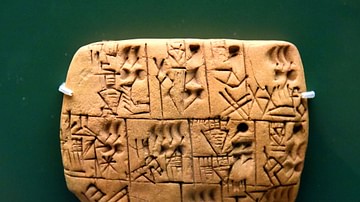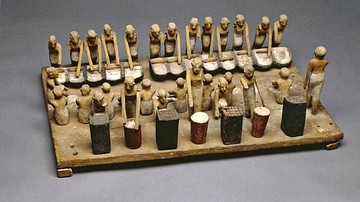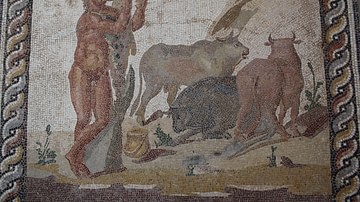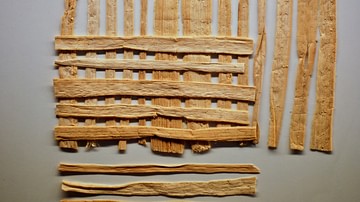Agriculture was the foundation of the ancient Egyptian economy and vital to the lives of the people of the land. Agricultural practices began in the Delta Region of northern Egypt and the fertile basin known as the Faiyum in the Predynastic Period in Egypt (c. 6000 - c. 3150 BCE), but there is evidence of agricultural use and overuse of the land dating back to 8000 BCE.

Egyptologist and historian Margaret Bunson defines ancient Egyptian agriculture as "the science and practice of the ancient Egyptians from predynastic times that enabled them to transform an expanse of semiarid land into rich fields after each inundation of the Nile" (4). In this, she is referring to the yearly flooding of the Nile River which rose over its banks to deposit nutrient-rich soil on the land, allowing for the cultivation of crops. Without the inundation, Egyptian culture could not have taken hold in the Nile River Valley and their civilization would never have been established. So important was the Nile flood that scholars believe many, if not most, of the best known Egyptian myths are linked to, or directly inspired by, this event. The story of the death and resurrection of the god Osiris, for example, is thought to have initially been an allegory for the life-giving inundation of the Nile, and numerous gods throughout Egypt's history are directly or indirectly linked to the river's flood.
So fertile were the fields of Egypt that, in a good season, they produced enough food to feed every person in the country abundantly for a year and still have surplus, which was stored in state-owned granaries and used in trade or saved for leaner times. A bad growing season was always the result of a shallow inundation by the Nile, no matter the amount of rainfall or what other factors came into play.
Tools & Practices
The yearly inundation was the most important aspect of Egyptian agriculture, but the people obviously still needed to work the land. Fields had to be plowed and seed sown and water moved to different areas, which led to the invention of the ox-drawn plow and improvements in irrigation. The ox-drawn plow was designed in two gauges: heavy and light. The heavy plow went first and cut the furrows while the lighter plow came behind turning up the earth.
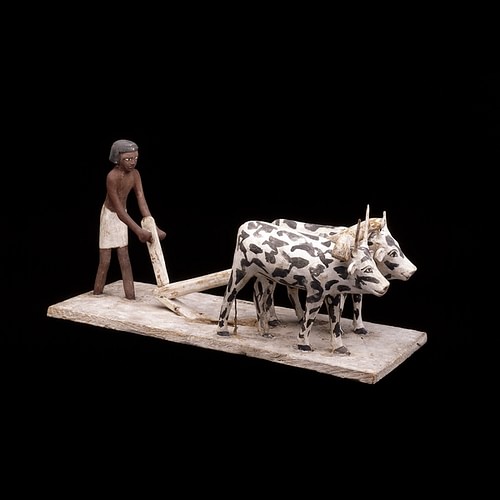
Once the ground was broken and the clods dispersed, seed was carried to the field in baskets and workers filled smaller baskets or sacks from these larger containers. The most common means of sowing the earth was to carry a basket in one arm while flinging the seed with the other hand.
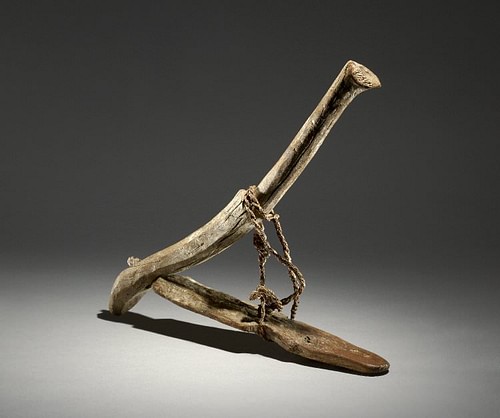
Some farmers were able to afford the luxury of a large basket one attached to the chest by hemp straps which enabled one to use two hands in sowing. To press the seed into the furrows, livestock was driven across the field and the furrows were then closed by workers with hoes. All of this work would have been for nothing, however, if the seeds were denied sufficient water and so regular irrigation of the land was extremely important.
Canals
Egyptian irrigation techniques were so effective they were implemented by the cultures of Greece and Rome. New irrigation methods were introduced during the Second Intermediate Period of Egypt (c. 1782 - c.1570 BCE) by the people known as the Hyksos, who settled in Avaris in Lower Egypt and the Egyptians would further improve upon these techniques, such the expanded use of the canal. The yearly inundation of the Nile was essential to Egyptian life, but irrigation canals were necessary to carry water to outlying farms and villages as well as to maintain even saturation of crops near the river.
Egyptologist Barbara Watterson notes how the Delta Region of Lower Egypt was far more fertile than the fields of Upper Egypt toward the south and so "the Upper Egyptian farmer had to be inventive and, at an early date, learned to cooperate with his neighbours in harnessing the river water through the building of irrigation canals and drainage ditches" (40).
These canals were carefully engineered to efficiently water the fields but, most importantly, not to interfere with anyone else's crops or canals. This aspect of canal construction was so important that it was included in the Negative Confession, the proclamation a soul would make after death when it stood in judgment. Among the Confessions are numbers 33 and 34 in which the soul claims it has never obstructed water in another's canal and has never cut into someone else's canal illegally. After receiving permission to dig a canal, estate owners and farmers were responsible for the proper construction and maintenance of it. Bunson writes:
Early farmers dug trenches from the Nile shore to the farmlands, using draw wells and then the Shaduf, a primitive machine that allowed them to raise levels of water from the Nile into canals...Fields thus irrigated produced abundant annual crops. From the predynastic times agriculture was the mainstay of the Egyptian economy. Most Egyptians were employed in agricultural labors, either on their own lands or on the estates of the temples or nobles. Control of irrigation became a major concern and provincial officials were held responsible for the regulation of water. (4)
Bunson is here referring not only to disputes between people over water rights but the almost sacred responsibility of officials to ensure that water was not wasted, which included making certain that canals were kept in good working order. The regional governor (nomarch) of a certain district (nome) delegated authority to those under him for the building of state-sponsored canals and for the maintenance of both public and private waterways. Fines were levied for improperly constructed or poorly maintained canals which wasted water or on those who diverted water from others without permission.
The state-sponsored canals were often ornate works of art. When Ramesses II the Great (1279-1213 BCE) built his city of Per-Ramesses at the site of ancient Avaris, his canals were said to be the most impressive in all of Egypt. These public works were elaborately ornamented while, at the same time, functioning with such high efficiency that the entire region around Per-Ramesses flourished. Hydraulics were used from the Middle Kingdom of Egypt (2040-1782 BCE) onwards to drain land and move water efficiently through the land. An abundance of crops not only meant that the people were well fed but that the economy would thrive through trade of agricultural goods.
Animal Husbandry, Crops, & Products
The Egyptians maintained a largely vegetarian diet. Meat was expensive, could not last long as there was no concept of refrigeration, and so was primarily reserved for nobility, the wealthy, and for festivals and special occasions. Animals used for meat included cattle, lambs, sheep, goats, poultry, and for the nobles, antelope killed in the hunt. Pigs were regularly eaten in Lower Egypt while shunned (along with anyone associated with them) in Upper Egypt during certain periods. Fish was the most common food of the lower classes but considered unclean by many upper-class Egyptians; priests, for example, were forbidden to eat fish.
The staple crops of ancient Egypt were emmer (a wheat-grain), chickpeas and lentils, lettuce, onions, garlic, sesame, wheat, barley, papyrus, flax, the castor oil plant, and - during the period of the New Kingdom (c. 1570-1069 BCE) at Thebes - the opium poppy.
Opium was used for medicinal purposes and recreation from as early as c. 3400 BCE in Sumeria, where the Mesopotamians referred to it as Hul Gil ('the joy plant'), and cultivation of the poppy passed on to other cultures such as the Assyrian and Egyptian. By the time of the New Kingdom, the opium trade was quite lucrative and contributed to the great wealth of the city of Thebes.

Papyrus was used for a number of products. Although it is most commonly recognized as the raw material for paper, papyrus was also used to make sandals, rope, material for dolls, boxes, baskets, mats, window shades, as a food source, and even to make small fishing boats. The castor oil plant was crushed and used for lamp oil and also as a tonic. Flax was used for rope and clothing and sometimes in the manufacture of footwear.
Among the most important crops was the emmer which went into the production of beer, the most popular drink in Egypt, and bread, a daily staple of the Egyptian diet. When Rome annexed Egypt after 30 BCE, wheat production gradually declined in favor of the cultivation of grapes because the Romans favored wine over beer. Prior to the coming of Rome, however, emmer was probably the most important crop regularly grown in Egypt after papyrus.
Farmers & Trade
The individual farmers would make their living from the crops in a number of ways. If one were a private landowner, of course, one could do as one wished with one's crops (keeping in mind that one would have to pay a certain amount to the state in taxes). Most farmers worked on land owned by the nobles or the priests or other wealthy members of society, and so the men would typically tend the fields and surrender the produce to the noble while keeping a small amount for personal use. The wives and children of these tenant farmers often kept small gardens they tended for the family, but agriculture was primarily a man's work. Egyptologist Joyce Tyldesley writes:
Women are not conventionally illustrated ploughing, sowing, or looking after the animals in the fileds, but they are shown providing refreshments for the labourers, while gleaning was an approved female outdoor activity recorded in several tomb scenes; women and children follow the official harvesters and pick up any ears of corn [ie. grains, not maize] which have been left behind. Of equal, or perhaps greater, importance were the small-scale informal transactions conducted between women, with one wife, for example, simply agreeing to swap a jug of her homemade beer for her neighbour's excess fish. This type of exchange, which formed the basis of the Egyptian economy, allowed the careful housewife to convert her surplus directly into useable goods, just as her husband was able to exchange his labour for his daily bread. (137-138)
Such exchanges, in good years, often involved the family garden and produce served as currency in transactions. Fishing was a daily activity for many, if not most, of the lower classes as a means to supplement their income, and Egyptians were known as expert fishermen. Ancient Egypt was a cashless society up until the time of the Persian Invasion of 525 BCE, and so the more one had to barter with, the better one's situation.
Agriculture & Personal Wealth
The monetary unit of ancient Egypt was the deben which, according to historian James C. Thompson, "functioned much as the dollar does in North America today to let customers know the price of things, except that there was no deben coin" (Egyptian Economy, 1). A deben was "approximately 90 grams of copper; very expensive items could also be priced in debens of silver or gold with proportionate changes in value" (ibid). Thompson continues:
Since seventy-five litters of wheat cost one deben and a pair of sandals also cost one deben, it made perfect sense to the Egyptians that a pair of sandals could be purchased with a bag of wheat as easily as with a chunk of copper. Even if the sandal maker had more than enough wheat, she would happily accept it in payment because it could easily be exchanged for something else. The most common items used to make purchases were wheat, barley, and cooking or lamp oil, but in theory almost anything would do. (1)
This same system of barter which took place on the most modest scale throughout the villages of Egypt was also the paradigm in the cities and in international trade. Egypt shipped its produce to Mesopotamia, the Levant, India, Nubia, and the Land of Punt (modern-day Somalia) among others. Crops were harvested and stored at the local level and then a portion collected by the state and moved to the Royal Granaries in the capital as taxes.
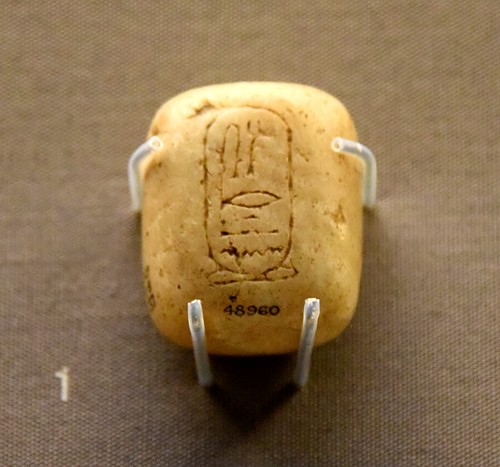
Bunson notes how "assessors were sent from the capital to the provinces to collect taxes in the form of grain" and how the local temples "had storage units and were subject to taxes in most eras unless exempted for a particular reason or favor" (5). Temples to especially popular gods, such as Amun, grew wealthy from agriculture, and Egypt's history repeatedly turns on conflicts between the priests of Amun and the throne.
Conclusion
Following the annexation of Egypt by Rome, Egypt served as the "breadbasket" of the Roman Empire and was increasingly called upon to supply food for the empire's ever-expanding reach. This situation would continue even after the fall of the Western Roman Empire in 476 CE as Egypt continued to be controlled by the Eastern (Byzantine) Roman Empire until it was taken in the Arab Invasion of the 7th century CE.
Between the time of the Arab Invasion and the fall of the Byzantine Empire in 1453 CE, Egypt continued its long tradition of agricultural pursuits which have been maintained since. Although the major commercial fields and farms of Egypt in the present day are worked using more advanced technology, the old patterns of agriculture can still be observed in small farms and villages.
